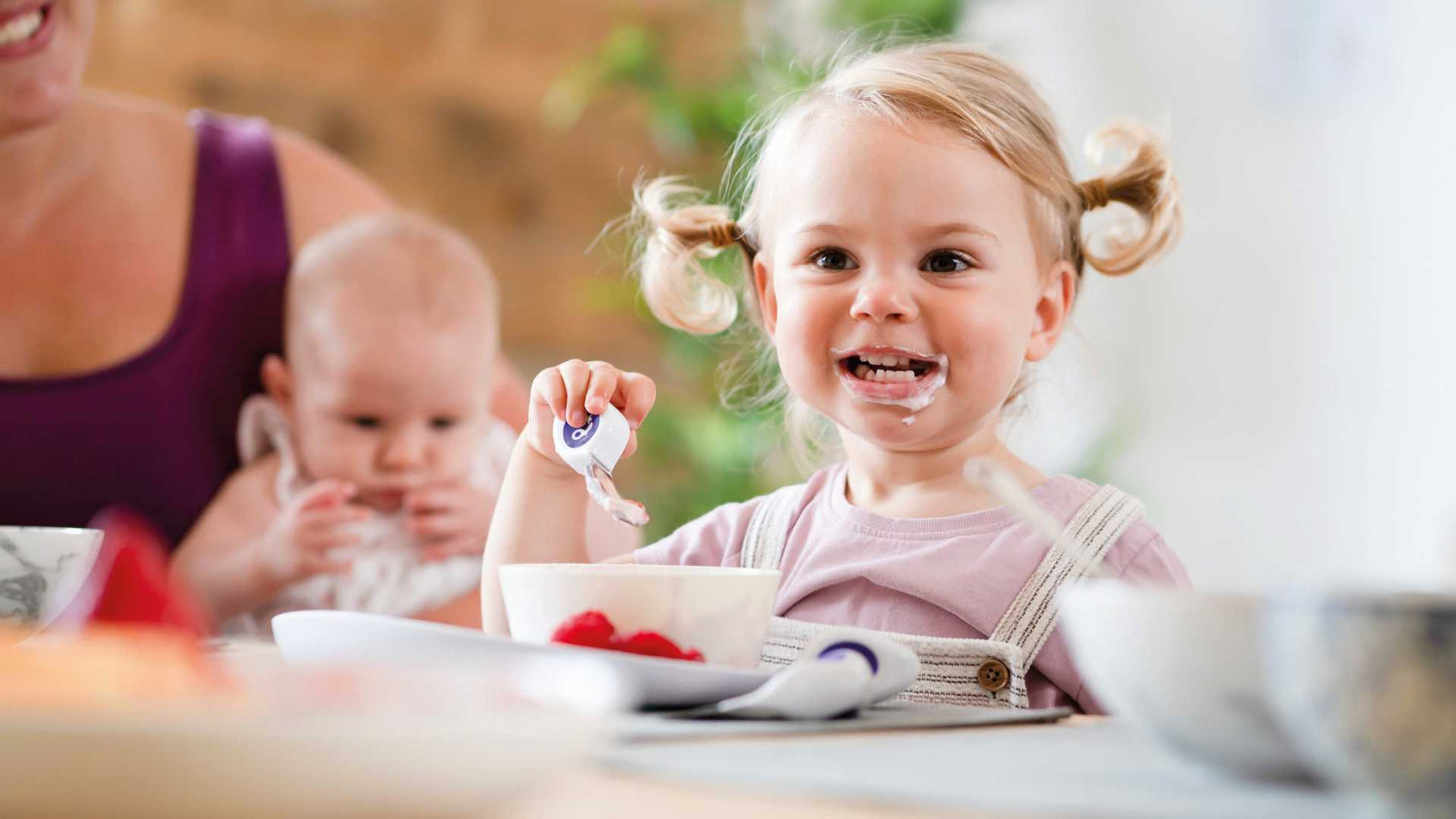Mealtimes provide the perfect setting for bringing your tribe together, whatever shape or size it may be. And sticking to consistent family meals as your kids grow does a world of good - strengthening bonds, nurturing healthy habits, boosting communication skills, and more. Of course, finding the time isn’t always easy… Our research told us almost 70% of British parents find either all or most mealtimes a challenge. But creativity goes a long way.
So, we’re here to help. As your baby becomes a busy toddler starting solids and beyond, capturing time side-by-side around the dinner table has huge advantages you’ll carry for years. From teaching manners to trying new foods, read on for why shared dinners do far more than fill tummies.

What are the benefits of sharing regular family meals?
Gathering consistently around the dinner table nurtures families in profound ways well beyond nutrition. While the meal itself feeds bellies, the laughs, bonding, and habits can shape dynamics for years. From building emotional well-being to strengthening relationships, regular family dinners offer advantages both seen and unseen:
● Nutritional Advantages
Cooking up dinner at home generally means more thoughtful nutrition all around. Without so many processed convenience options, parents control the ingredients - packing in more brain-boosting veggies, energising lean protein, and fibre-filled food.
Kids reap major benefits from those home-cooked real-food meals over factory-made frozen foods. Research shows just one extra family dinner prepared in the kitchen leads to a better intake of essential vitamins and minerals over time. Now that’s something to gather around the table for.
● Stronger Family Dynamics

Beyond nutrition, when families regularly come together for meals - whether that's the kitchen table, living room floor, or park picnic - there are definite relationship perks. Sharing meals fosters open communication between friends, families and across generations.
Studies show kids who connect consistently at mealtimes, including in blended, single-parent, foster, or non-traditional homes build resilience for their teen years and establish lasting bonds into adulthood. The simple act of breaking bread builds trust.
It may look different for every family, but consistency pays off in this fast-paced world. Pausing to share a bite - in any shape your situation allows - goes far in strengthening your crew's foundation one plate at a time. Togetherness tastes pretty great no matter what is served!
● Conserving Resources
When families enjoy meals together at home consistently, you can also conserve resources in helpful ways through:
● Reducing packaging waste by buying in bulk
● Cutting emissions from takeout packaging and delivery
● Lowering food costs by batch cooking
● Cutting down excess food waste using exact amounts needed
While environmental impact likely isn’t top of mind during hectic dinner hustle, every meal gathered around the table can help to protect our planet through simple savings that add up over thousands of shared dinners.
● Building Your Child’s Confidence

Responsive feeding is key for encouraging healthy eating behaviours and appetite regulation from the start. While letting kids serve themselves or select favourites first may not always be realistic, embracing opportunities when possible, pays off.
By providing children with a family environment with no pressure to eat certain items, they build positive associations and trust their own fullness cues over time. Sure, their attempts might prove messy at first! But enabling them to explore foods at their own pace works wonders for confidence and attitudes.
Tip! Using a toddler suction bowl that sticks securely can help new eaters explore finger foods with less mess. Specially-designed toddler cutlery can also assist little ones still developing coordination during family dinners too!
Better yet, regular family meals provide the perfect opportunity to lead by example when encouraging table manners and eating habits that children carry for life…
Tips for Eating Family Meals with your Baby or Toddler
Setting an Example at the Table for Kids

The habits and manners you demonstrate during family meals stick more than you may realise. Little observers carefully watch everything from passing plates to trying new flavours. Set a positive example by:
- Gently remind them to focus on their bites without demanding expert manners. Sitting still, especially at the dinner table, is a skill they're honing!
- Let those infant and toddler tummies guide the way - patiently offer or encourage bites on their level following their baby food journey.
- Don't stress if they let you know they’re full by pushing away food or waving a symbolic “all done.” Listen for those cues that mealtime is over. If uncertain, asking “one more bite?” checks if they’re really finished. No need to get worried or force more food - there's always the next meal or tomorrow to offer something new. Stay positive about exploring different tastes over time. The key is respecting when your little one is communicating “enough” in these early years.
- Tune into cues your child gives if disinterested or full. And remember, they're just communicating, not misbehaving.
- Shower your little eater with high fives for trying unknown foods or properly using their utensils to build their confidence.
- If your toddler starts throwing food in frustration, take a deep breath! This common phase will pass. Check out tips in our blog for stopping your toddler throwing food.
Consider the example your actions set - your mini meal mates will likely follow your lead for years to come.
Overcoming Picky Eating in Children

New tastes can pose scary territory for tiny palates. The bright colours and complex flavours we love can sometimes overwhelm their fledgling senses. But gently nudging them to branch out beyond buttered noodles expands horizons (and nutrition!).
With creativity and empathy, their world of accepted foods continually expands. Here are some tips for introducing new foods to fussy toddlers:
- Praise brave attempts at trying new foods, whether they swallow or simply lick.
- Avoid reacting negatively if they clearly dislike or spit out an item after tasting.
- Use repeated, low-pressure exposure over time to support tasting new items at their own pace.
- Try to serve one familiar food alongside a new introduction to help ease the transition.
- When introducing spicy flavours, offer just a small lick of hot sauce rather than overpowering dishes kids eat.
Tip! Respect when your tot says no, but continue calmly presenting previously rejected ingredients.
Tastes change dramatically in children under five as their senses mature. What triggered tears last month might earn eager grabs tomorrow. Praise every brave attempt, whether they swallow or not.
Making Family Meals Meaningful

Invite your mini master chefs to help whip up family feasts to turn food prep from everyday task into kitchen magic! Sure, including toddlers in food prep can mean more mess, spills and time. But nothing sparks their curiosity quite like hands-on participation. Here are some ideas for bringing little helpers to the table:
- Have your child tear lettuce for salad or decide between side veggie options
- Show kids how to safely stir, season, and shape components like meatballs or cupcakes.
- Let toddlers practice mixing and mashing cooked ingredients to make spreads, dipping sauces or sandwich fillings under supervision.
- Give simple measuring tasks like adding pre-measured dry goods or liquid ingredients.
- Help them to follow recipe steps for combining and whisking items in a bowl.
- Allow kids to select place settings, make table decorations or art to personalise the family dining space.
- Why not arm your little chef with a super-safe doddl toddler knife and get them to cut up some fruit or veggies too? It builds skills!
When kids take ownership over elements at dinner time, their sense of contribution sticks more than forced bites. It’s always best to empower them in age-appropriate ways that fit their skills.
Tip! Allow baby-led exploration with either hands or child-friendly cutlery. Letting little ones try foods at their own pace helps them emulate parents using proper utensils in the earliest stages.
Fitting Family Meals In

Finding time for family meals amid packed schedules overflowing with school, jobs, and activities can seem downright impossible some weeks. But don't abandon hope. Getting creative makes coordinating family meals amid busy schedules doable:
- Begin by defining what shared dining looks like for your family - it differs for us all. One week it may mean a simple breakfast before rushing out the door. The next could allow gathering around the dinner table for 30 minutes of connection.
- Get ahead on weekends by taking the time to do some food prep. This can help you during the week to assemble some delicious family meals using our toddler recipes.
- When frantic days limit proper sit-down dinners, embrace simple picnic-style floor meals. Or wake up a few minutes earlier for breakfast chatter.
Tip! When it comes to family mealtimes, consistency matters way more than presenting perfect Instagram-worthy meals. Don't stress about impressing anyone! Focus instead on meaningful bonding, laughter, and togetherness over whatever ends up on the table.
Gearing Up for Family Feeding

Bringing your family together around the dinner table pays off big time - passing the plates and forks lets everyone talk about their day, it encourages a willingness to try new foods, and creates unbreakable bonds bite by bite.
The journey starts early, so patiently navigating predictable challenges with infants and toddlers matters. But we know all spills and thrills that come with little diners finding their way can be chaotic for parents trying to stay sane.
That’s why doddl's toddler plates, suction bowl, and ergonomic cutlery specifically designed for family dining help rein in the disorder.
Check out doddl’s collection of mealtime must-haves to minimise the chaos so you can fully relish regular family dinners.





Leave a comment
This site is protected by hCaptcha and the hCaptcha Privacy Policy and Terms of Service apply.